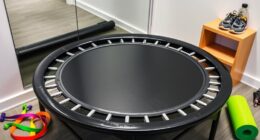When it comes to aiding individuals with memory problems, we understand the importance of offering assistance in different ways. This may involve using memory tools or breaking down tasks into easier steps. There are numerous helpful approaches that can support those in need.
However, one crucial aspect that often goes overlooked is the significance of creating a supportive environment that fosters a sense of security and familiarity. By addressing this fundamental need, we can truly make a meaningful impact on the lives of those we care for.
Key Takeaways
- Familiar, structured environment for comfort.
- Engage in memory-enhancing activities like puzzles.
- Use clear, simple communication techniques.
- Provide compassionate care with empathy and patience.
Understanding Memory Loss Conditions
When faced with the challenge of understanding memory loss conditions, it's essential to grasp the diverse range of cognitive impairments that can impact one's memory and cognitive function. Alzheimer's disease, the most common form of dementia, leads to progressive memory loss and cognitive decline. However, various other conditions such as vascular dementia, Lewy body dementia, and frontotemporal dementia also contribute to memory loss. These conditions can arise from factors like genetics, age, brain injuries, and underlying health conditions. Early diagnosis plays a pivotal role in managing memory loss effectively and enhancing the individual's quality of life.
For a person with memory loss and their family caregiver, navigating through these conditions can be challenging. Understanding the differences between various types of dementia and memory loss is crucial in developing appropriate coping strategies. Family caregivers play a vital role in supporting their loved ones through these difficulties. Encouraging early diagnosis and seeking professional guidance can significantly impact the management of memory loss conditions.
Creating a Supportive Environment

Creating a supportive environment for someone with memory loss involves establishing a familiar and structured setting that prioritizes comfort and security. Minimizing clutter and distractions can reduce confusion and enhance focus, making it easier for the individual to navigate their surroundings.
Using labels, color coding, and visual aids can significantly aid in memory recall and task completion, providing valuable cues for daily activities. Maintaining a consistent daily routine offers predictability and reduces anxiety, contributing to a sense of stability for the person with memory loss.
It's essential to ensure safety measures are in place, such as removing tripping hazards and securing potentially harmful items, to prevent accidents and promote a secure environment. By creating a structured and supportive space, we can help the individual feel more at ease, even as they navigate the challenges of memory loss. Additionally, providing adequate lighting and using assistive devices, like grab bars or nonslip mats, can significantly enhance safety and comfort. Implementing these fall prevention tips for seniors not only minimizes the risk of injury but also fosters a sense of independence for those experiencing cognitive or physical limitations. Simple yet thoughtful adjustments to their surroundings can make a meaningful difference in their daily lives.
Memory-Enhancing Activities and Strategies
To support individuals with memory loss, engaging in memory-enhancing activities and strategies can play a vital role in stimulating cognitive functions and memory retention. By incorporating activities like puzzles, crosswords, and brain games, one can keep the mind active and improve memory recall. Physical exercise is also crucial as it enhances blood flow to the brain, aiding in memory retention. Mindfulness techniques such as meditation and deep breathing help reduce stress levels, which in turn can positively impact memory. Establishing a consistent routine and daily schedule provides structure and supports memory consolidation. Additionally, mnemonic devices, visualization techniques, and association strategies serve as valuable tools in remembering important information and events.
| Memory-Enhancing Activities and Strategies | Benefits | Implementation |
|---|---|---|
| Puzzles, Crosswords, Brain Games | Stimulate cognitive functions | Incorporate into daily routine |
| Physical Exercise | Improve blood flow to brain | Engage in regular physical activities |
| Mindfulness Techniques | Reduce stress levels | Practice meditation and deep breathing |
| Mnemonic Devices, Association Strategies | Aid in remembering | Use for important information retention |
Effective Communication Techniques

Using clear and simple language is essential in effectively communicating with individuals experiencing memory loss. When engaging with someone with memory loss, it's crucial to maintain eye contact, speak slowly, and allow time for processing information.
Encouraging engagement by repeating key points can help reinforce memory retention and aid in comprehension. It's important to show patience, give the individual time to respond, and offer reassurance during interactions to foster a sense of understanding and comfort.
Additionally, utilizing visual aids, gestures, and non-verbal cues can enhance communication by providing additional context and clarity to the conversation. By incorporating these techniques into your communication approach, you can create a more supportive and effective environment for individuals with memory loss, helping them feel more connected and understood.
Providing Compassionate Care
When caring for individuals experiencing memory loss, it's crucial to approach each interaction with empathy and patience, ensuring their comfort and well-being are prioritized.
A loved one with memory loss, such as a person with dementia, requires understanding and support. Using simple language can help facilitate communication and avoid confusion. Encouraging reminiscence and storytelling can trigger memories and engage them in meaningful ways.
Creating a calm and familiar environment is essential to reduce anxiety and enhance their overall comfort. It's important to offer assistance with daily tasks while also respecting their independence and preserving their dignity.
Providing compassionate care involves not only meeting their physical needs but also attending to their emotional well-being. By being empathetic, patient, and supportive, we can make a significant difference in the quality of life for those struggling with memory loss.
Frequently Asked Questions
What Do You Say to Someone With Memory Loss?
When talking to someone with memory loss, we should use clear language and remind them of familiar information to aid their recollection. It's crucial to avoid arguments and corrections, opting for empathy and understanding instead.
Reassurance and support are key in making the person feel valued. Encourage open communication and provide a safe space for them to express their thoughts and feelings without judgment.
How Can You Help Someone Who Is Losing Their Memory?
We can help someone who's losing their memory by providing support through memory aids like calendars and reminders. Breaking down tasks into smaller steps with written instructions can assist in completing daily activities more effectively.
Accompanying the individual when going out and emphasizing emotional attachment can prevent them from getting lost and help with face recognition challenges. Respecting their beliefs, consulting professionals for dietary changes, and finding alternative worship methods are also important in supporting them.
How Do You Live With Someone With Short-Term Memory Loss?
Living with someone with short-term memory loss requires patience, understanding, and adaptability.
We strive to establish routines, use visual aids, and foster a supportive environment.
By maintaining a calm atmosphere and providing gentle reminders, we aim to minimize stress and confusion.
Our goal is to create a safe and secure space where our loved one feels empowered and cared for amidst the challenges of memory loss.
How Do You Communicate With Someone Who Has Memory Loss?
We communicate with someone who's memory loss by using simple language, maintaining eye contact, and speaking in a calm tone. Repetition of important information helps memory retention.
Encouraging them to express their thoughts and feelings fosters connection. Visual aids, gestures, and cues support communication.
It's vital to be patient and understanding, creating a safe and empathetic space for effective interaction with individuals experiencing memory loss.
Conclusion
In conclusion, it's essential to remember that providing support and understanding to someone with memory loss can significantly improve their quality of life. Did you know that over 50 million people worldwide are living with dementia?
By creating a supportive environment, engaging in memory-enhancing activities, practicing effective communication, and offering compassionate care, we can help individuals with memory loss navigate their daily lives with dignity and comfort.
Let's continue to show empathy and support for those facing memory challenges.








